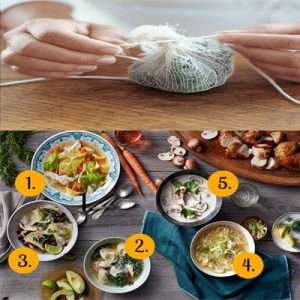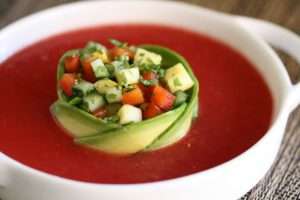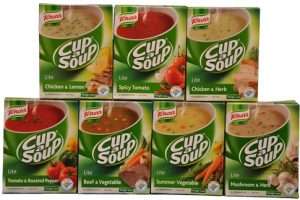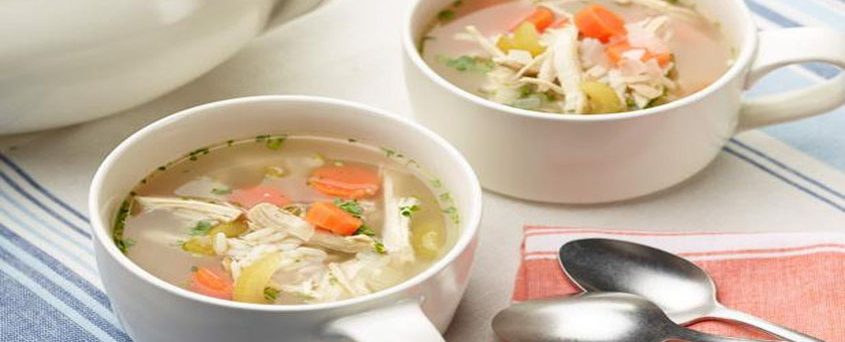Soups
 Most soups are made up of three parts
Most soups are made up of three parts
- The liquid
- The flavoring
- The thickening or binding
So that every soup depends upon a good well flavored liquid something to give it its own distinctive character and taste and the right amount of blending or thickening material. If good stock is available rich in meat or vegetable extract this is easily made into soup.
Stock
 Save all bits and pieces of meat, poultry, bacon rinds, bones and vegetables (not potato), celery, lettuce, tomato and onion trimmings etc., cover with water and simmer for hours with a bouquet grain and salt. Taste, season carefully and strain. When cold remove any fat and use for all soups and sauces.Add meat or vegetable extracts if meat and bones are scarce. Save the liquid in which meat, vegetables, or poultry has been boiled. Reduce this and use as stock.
Save all bits and pieces of meat, poultry, bacon rinds, bones and vegetables (not potato), celery, lettuce, tomato and onion trimmings etc., cover with water and simmer for hours with a bouquet grain and salt. Taste, season carefully and strain. When cold remove any fat and use for all soups and sauces.Add meat or vegetable extracts if meat and bones are scarce. Save the liquid in which meat, vegetables, or poultry has been boiled. Reduce this and use as stock.
To Make a Bouquet Garni
 Tie loosely in a piece of muslin a few peppercorns, a blade of mace, a sprig of parsley (fresh or dried), thyme, a bay leaf, and two cloves.
Tie loosely in a piece of muslin a few peppercorns, a blade of mace, a sprig of parsley (fresh or dried), thyme, a bay leaf, and two cloves.
Variations of Soups
There are three main varieties of soups thin, purees and cream soups.
This stock will form the basis of any them.Thickening or Binding for soups.In purees the main ingredients of the soup are sieved or mashed to thicken it,and then, to hold the solid matter in suspension, the soup is bound together with some thickening or liaison.This may be:
- Flour or Corn flour and water mixed to a smooth cream and added.
- Use about 1 oz., to 2pts puree and boil up
- Sago. Use 1 to 2 oz. puree mix with a little water stirs into puree and boil until clear.
- A Roux using 1 oz. fat and 1 oz. flour to 2 pt. Puree stock or milk.
To make a Roux
 Heat fat (dripping, margarine or butter) in thick saucepan, stir in flour until it sizzles without browning. Draw away from heat, stir in a little liquid, let it thicken gradually add more liquid let it thicken and repeat this process until all the liquid is incorporated to make a smooth cream boil up.
Heat fat (dripping, margarine or butter) in thick saucepan, stir in flour until it sizzles without browning. Draw away from heat, stir in a little liquid, let it thicken gradually add more liquid let it thicken and repeat this process until all the liquid is incorporated to make a smooth cream boil up.
Garnishing Soups
 Soups without solid matter in them are usually garnished, by adding to them:
Soups without solid matter in them are usually garnished, by adding to them:
Chopped parsley, grated cheese, cooked vegetables, cooked peas, fancy cut pieces of savory custard, fine strips of cooked vegetables or egg white, rings of cooked macaroni or Croutons (small dice of bread fried until brown and crisp and well drained of all fat,) or snippets (small shaped pieces of crisp toast)
Flavoring Soups
 The clever cook uses all her oddments to flavor soups an endless combination of flavors may thus be obtained.A tin of soup will form a useful foundation, to which you may add liquid binding, flavoring and garnish at will, to make a great variety of soups.Taste and Texture are all important.Do not serve the soup until these are right. So many soups are tasteless, or too thick or thin.If necessary, add cheese, or sauce, or wine, or something tasty, at the last moment, and thicken with blended flour, or thin with milk or stock and then boil up again.
The clever cook uses all her oddments to flavor soups an endless combination of flavors may thus be obtained.A tin of soup will form a useful foundation, to which you may add liquid binding, flavoring and garnish at will, to make a great variety of soups.Taste and Texture are all important.Do not serve the soup until these are right. So many soups are tasteless, or too thick or thin.If necessary, add cheese, or sauce, or wine, or something tasty, at the last moment, and thicken with blended flour, or thin with milk or stock and then boil up again.




